Evidence Based Practice in Nursing
VerifiedAdded on 2022/12/23
|10
|3589
|66
AI Summary
This essay provides a critical appraisal of a systematic review on the effectiveness of interventions to improve hand hygiene compliance of nurses in the hospital setting. It discusses the targeted question, suitability of selected studies, and summary of findings. The review highlights the importance of evidence-based practice in reducing healthcare associated infections.
Contribute Materials
Your contribution can guide someone’s learning journey. Share your
documents today.

Evidence Based Practice in Nursing
1
1
Secure Best Marks with AI Grader
Need help grading? Try our AI Grader for instant feedback on your assignments.
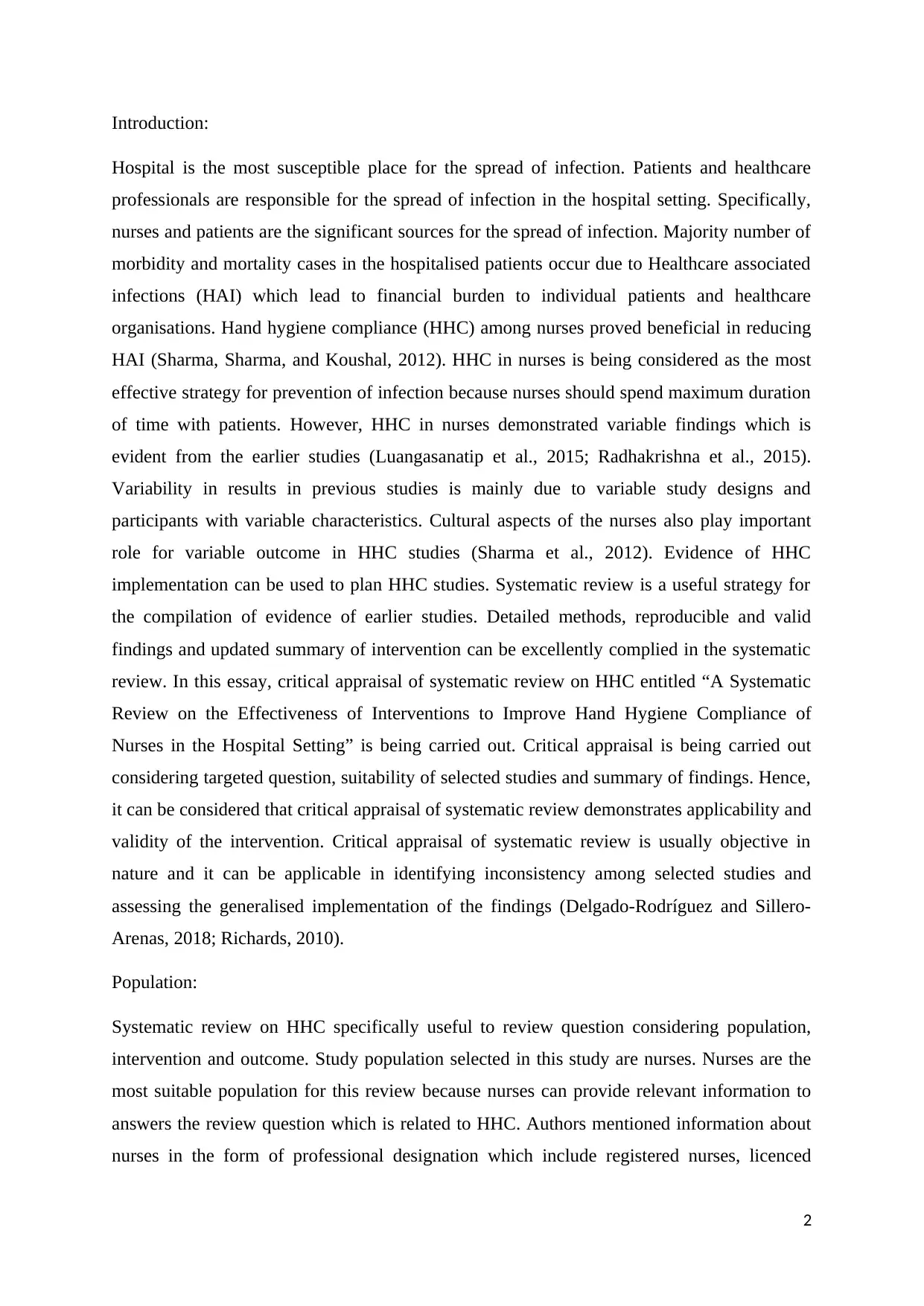
Introduction:
Hospital is the most susceptible place for the spread of infection. Patients and healthcare
professionals are responsible for the spread of infection in the hospital setting. Specifically,
nurses and patients are the significant sources for the spread of infection. Majority number of
morbidity and mortality cases in the hospitalised patients occur due to Healthcare associated
infections (HAI) which lead to financial burden to individual patients and healthcare
organisations. Hand hygiene compliance (HHC) among nurses proved beneficial in reducing
HAI (Sharma, Sharma, and Koushal, 2012). HHC in nurses is being considered as the most
effective strategy for prevention of infection because nurses should spend maximum duration
of time with patients. However, HHC in nurses demonstrated variable findings which is
evident from the earlier studies (Luangasanatip et al., 2015; Radhakrishna et al., 2015).
Variability in results in previous studies is mainly due to variable study designs and
participants with variable characteristics. Cultural aspects of the nurses also play important
role for variable outcome in HHC studies (Sharma et al., 2012). Evidence of HHC
implementation can be used to plan HHC studies. Systematic review is a useful strategy for
the compilation of evidence of earlier studies. Detailed methods, reproducible and valid
findings and updated summary of intervention can be excellently complied in the systematic
review. In this essay, critical appraisal of systematic review on HHC entitled “A Systematic
Review on the Effectiveness of Interventions to Improve Hand Hygiene Compliance of
Nurses in the Hospital Setting” is being carried out. Critical appraisal is being carried out
considering targeted question, suitability of selected studies and summary of findings. Hence,
it can be considered that critical appraisal of systematic review demonstrates applicability and
validity of the intervention. Critical appraisal of systematic review is usually objective in
nature and it can be applicable in identifying inconsistency among selected studies and
assessing the generalised implementation of the findings (Delgado-Rodríguez and Sillero-
Arenas, 2018; Richards, 2010).
Population:
Systematic review on HHC specifically useful to review question considering population,
intervention and outcome. Study population selected in this study are nurses. Nurses are the
most suitable population for this review because nurses can provide relevant information to
answers the review question which is related to HHC. Authors mentioned information about
nurses in the form of professional designation which include registered nurses, licenced
2
Hospital is the most susceptible place for the spread of infection. Patients and healthcare
professionals are responsible for the spread of infection in the hospital setting. Specifically,
nurses and patients are the significant sources for the spread of infection. Majority number of
morbidity and mortality cases in the hospitalised patients occur due to Healthcare associated
infections (HAI) which lead to financial burden to individual patients and healthcare
organisations. Hand hygiene compliance (HHC) among nurses proved beneficial in reducing
HAI (Sharma, Sharma, and Koushal, 2012). HHC in nurses is being considered as the most
effective strategy for prevention of infection because nurses should spend maximum duration
of time with patients. However, HHC in nurses demonstrated variable findings which is
evident from the earlier studies (Luangasanatip et al., 2015; Radhakrishna et al., 2015).
Variability in results in previous studies is mainly due to variable study designs and
participants with variable characteristics. Cultural aspects of the nurses also play important
role for variable outcome in HHC studies (Sharma et al., 2012). Evidence of HHC
implementation can be used to plan HHC studies. Systematic review is a useful strategy for
the compilation of evidence of earlier studies. Detailed methods, reproducible and valid
findings and updated summary of intervention can be excellently complied in the systematic
review. In this essay, critical appraisal of systematic review on HHC entitled “A Systematic
Review on the Effectiveness of Interventions to Improve Hand Hygiene Compliance of
Nurses in the Hospital Setting” is being carried out. Critical appraisal is being carried out
considering targeted question, suitability of selected studies and summary of findings. Hence,
it can be considered that critical appraisal of systematic review demonstrates applicability and
validity of the intervention. Critical appraisal of systematic review is usually objective in
nature and it can be applicable in identifying inconsistency among selected studies and
assessing the generalised implementation of the findings (Delgado-Rodríguez and Sillero-
Arenas, 2018; Richards, 2010).
Population:
Systematic review on HHC specifically useful to review question considering population,
intervention and outcome. Study population selected in this study are nurses. Nurses are the
most suitable population for this review because nurses can provide relevant information to
answers the review question which is related to HHC. Authors mentioned information about
nurses in the form of professional designation which include registered nurses, licenced
2
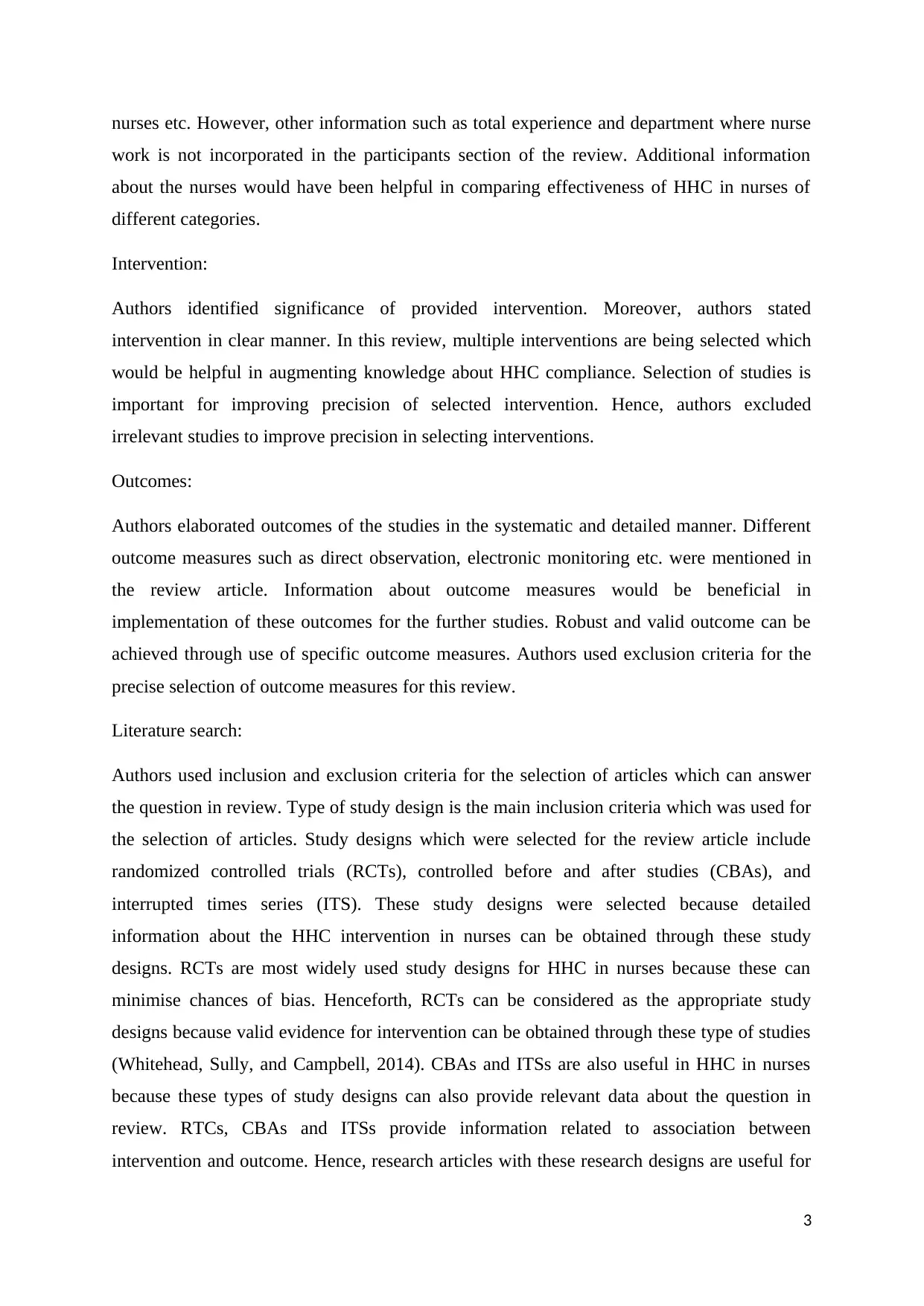
nurses etc. However, other information such as total experience and department where nurse
work is not incorporated in the participants section of the review. Additional information
about the nurses would have been helpful in comparing effectiveness of HHC in nurses of
different categories.
Intervention:
Authors identified significance of provided intervention. Moreover, authors stated
intervention in clear manner. In this review, multiple interventions are being selected which
would be helpful in augmenting knowledge about HHC compliance. Selection of studies is
important for improving precision of selected intervention. Hence, authors excluded
irrelevant studies to improve precision in selecting interventions.
Outcomes:
Authors elaborated outcomes of the studies in the systematic and detailed manner. Different
outcome measures such as direct observation, electronic monitoring etc. were mentioned in
the review article. Information about outcome measures would be beneficial in
implementation of these outcomes for the further studies. Robust and valid outcome can be
achieved through use of specific outcome measures. Authors used exclusion criteria for the
precise selection of outcome measures for this review.
Literature search:
Authors used inclusion and exclusion criteria for the selection of articles which can answer
the question in review. Type of study design is the main inclusion criteria which was used for
the selection of articles. Study designs which were selected for the review article include
randomized controlled trials (RCTs), controlled before and after studies (CBAs), and
interrupted times series (ITS). These study designs were selected because detailed
information about the HHC intervention in nurses can be obtained through these study
designs. RCTs are most widely used study designs for HHC in nurses because these can
minimise chances of bias. Henceforth, RCTs can be considered as the appropriate study
designs because valid evidence for intervention can be obtained through these type of studies
(Whitehead, Sully, and Campbell, 2014). CBAs and ITSs are also useful in HHC in nurses
because these types of study designs can also provide relevant data about the question in
review. RTCs, CBAs and ITSs provide information related to association between
intervention and outcome. Hence, research articles with these research designs are useful for
3
work is not incorporated in the participants section of the review. Additional information
about the nurses would have been helpful in comparing effectiveness of HHC in nurses of
different categories.
Intervention:
Authors identified significance of provided intervention. Moreover, authors stated
intervention in clear manner. In this review, multiple interventions are being selected which
would be helpful in augmenting knowledge about HHC compliance. Selection of studies is
important for improving precision of selected intervention. Hence, authors excluded
irrelevant studies to improve precision in selecting interventions.
Outcomes:
Authors elaborated outcomes of the studies in the systematic and detailed manner. Different
outcome measures such as direct observation, electronic monitoring etc. were mentioned in
the review article. Information about outcome measures would be beneficial in
implementation of these outcomes for the further studies. Robust and valid outcome can be
achieved through use of specific outcome measures. Authors used exclusion criteria for the
precise selection of outcome measures for this review.
Literature search:
Authors used inclusion and exclusion criteria for the selection of articles which can answer
the question in review. Type of study design is the main inclusion criteria which was used for
the selection of articles. Study designs which were selected for the review article include
randomized controlled trials (RCTs), controlled before and after studies (CBAs), and
interrupted times series (ITS). These study designs were selected because detailed
information about the HHC intervention in nurses can be obtained through these study
designs. RCTs are most widely used study designs for HHC in nurses because these can
minimise chances of bias. Henceforth, RCTs can be considered as the appropriate study
designs because valid evidence for intervention can be obtained through these type of studies
(Whitehead, Sully, and Campbell, 2014). CBAs and ITSs are also useful in HHC in nurses
because these types of study designs can also provide relevant data about the question in
review. RTCs, CBAs and ITSs provide information related to association between
intervention and outcome. Hence, research articles with these research designs are useful for
3

authors for making relevant conclusion. Two search strategies were used in this review article
which helped in identifying all the relevant research articles. All the relevant search items
were used for searching articles from different databases such as Cochrane central register of
controlled trials, Medline, Embase, and the Cumulative Index to Nursing and Allied Health
Literature (CINAHL). Authors selected all the articles published prior to February 2014.
However, it is not possible to ensure whether unpublished research was being incorporated in
this review article. In this review, articles in English language only were included.
Henceforth, there is possibility of missing significant research on HHC from other languages.
Quality of review:
Authors decided certain inclusion criteria for selecting, retrieving and screening titles and
abstracts of each research article for its inclusion in the review. Quality of the selected
articles was ensured by assessing and appraising the articles by three reviewers. Validated
tool was used for assessing quality of the selected article. Cochrane Effective Practice and
Organization of Care Group (EPOC) tool and its recommendations were used for assessing
quality of articles. EPOC was being used for making critical decisions in selection of articles.
EPOC can be considered as best tool to provide rigorous evidence because of its worldwide
acceptability. Hence, this tool was used for selection of relevant articles with quality for
inclusion in the systematic review (Jones, Lees, Martin, and Dixon-Woods, 2014).
Inclusion and exclusion criteria are beneficial in the reducing ambiguity in population
selection, intervention, timeframe, setting, study design, study characteristics, study selection
process and outcomes. Poor outcome and diminished reproducibility are attributable to larger
ambiguity in the inclusion and exclusion criteria (Swift and Wampold, 2018). Multiple points
were taken into account in deciding inclusion and inclusion criteria. Hence, it proved
beneficial in minimising ambiguity.
Data synthesis:
Data synthesis is the critical aspect which decides quality of systematic review. Importance of
data synthesis is attributable to the compilation of data from diverse study designs and
outcomes from these study designs. Statistical tool is the important facet for pooling data
from different studies for its inclusion in the systematic review. Pooling relevant data form
the different studies can be helpful in answering question in review which is HHC. Data
synthesis enable both qualitative and quantitative outcome of specific intervention (Pollock
and Berge, 2018). However, statistical tool was not used in this article for compiling data
4
which helped in identifying all the relevant research articles. All the relevant search items
were used for searching articles from different databases such as Cochrane central register of
controlled trials, Medline, Embase, and the Cumulative Index to Nursing and Allied Health
Literature (CINAHL). Authors selected all the articles published prior to February 2014.
However, it is not possible to ensure whether unpublished research was being incorporated in
this review article. In this review, articles in English language only were included.
Henceforth, there is possibility of missing significant research on HHC from other languages.
Quality of review:
Authors decided certain inclusion criteria for selecting, retrieving and screening titles and
abstracts of each research article for its inclusion in the review. Quality of the selected
articles was ensured by assessing and appraising the articles by three reviewers. Validated
tool was used for assessing quality of the selected article. Cochrane Effective Practice and
Organization of Care Group (EPOC) tool and its recommendations were used for assessing
quality of articles. EPOC was being used for making critical decisions in selection of articles.
EPOC can be considered as best tool to provide rigorous evidence because of its worldwide
acceptability. Hence, this tool was used for selection of relevant articles with quality for
inclusion in the systematic review (Jones, Lees, Martin, and Dixon-Woods, 2014).
Inclusion and exclusion criteria are beneficial in the reducing ambiguity in population
selection, intervention, timeframe, setting, study design, study characteristics, study selection
process and outcomes. Poor outcome and diminished reproducibility are attributable to larger
ambiguity in the inclusion and exclusion criteria (Swift and Wampold, 2018). Multiple points
were taken into account in deciding inclusion and inclusion criteria. Hence, it proved
beneficial in minimising ambiguity.
Data synthesis:
Data synthesis is the critical aspect which decides quality of systematic review. Importance of
data synthesis is attributable to the compilation of data from diverse study designs and
outcomes from these study designs. Statistical tool is the important facet for pooling data
from different studies for its inclusion in the systematic review. Pooling relevant data form
the different studies can be helpful in answering question in review which is HHC. Data
synthesis enable both qualitative and quantitative outcome of specific intervention (Pollock
and Berge, 2018). However, statistical tool was not used in this article for compiling data
4
Secure Best Marks with AI Grader
Need help grading? Try our AI Grader for instant feedback on your assignments.
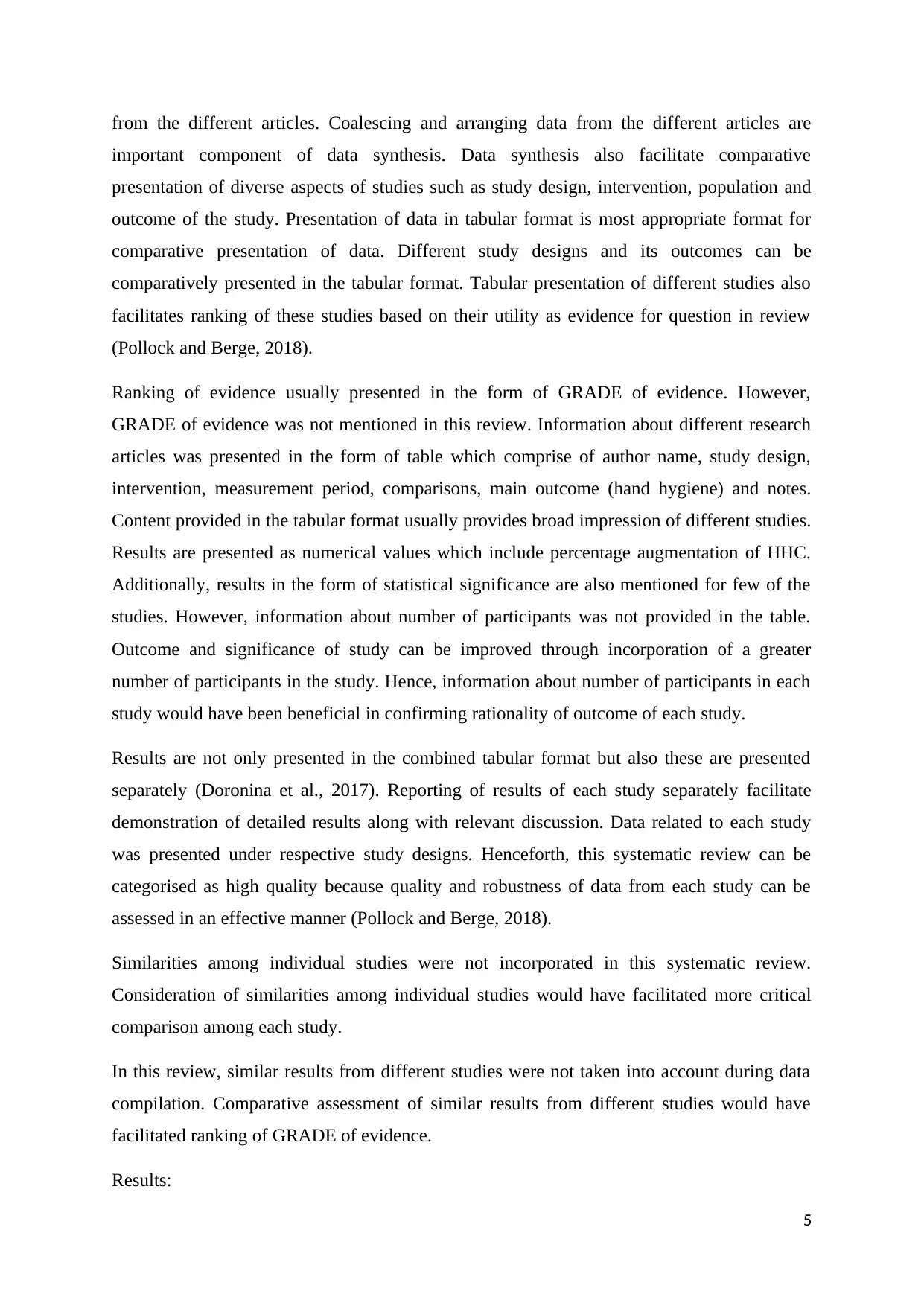
from the different articles. Coalescing and arranging data from the different articles are
important component of data synthesis. Data synthesis also facilitate comparative
presentation of diverse aspects of studies such as study design, intervention, population and
outcome of the study. Presentation of data in tabular format is most appropriate format for
comparative presentation of data. Different study designs and its outcomes can be
comparatively presented in the tabular format. Tabular presentation of different studies also
facilitates ranking of these studies based on their utility as evidence for question in review
(Pollock and Berge, 2018).
Ranking of evidence usually presented in the form of GRADE of evidence. However,
GRADE of evidence was not mentioned in this review. Information about different research
articles was presented in the form of table which comprise of author name, study design,
intervention, measurement period, comparisons, main outcome (hand hygiene) and notes.
Content provided in the tabular format usually provides broad impression of different studies.
Results are presented as numerical values which include percentage augmentation of HHC.
Additionally, results in the form of statistical significance are also mentioned for few of the
studies. However, information about number of participants was not provided in the table.
Outcome and significance of study can be improved through incorporation of a greater
number of participants in the study. Hence, information about number of participants in each
study would have been beneficial in confirming rationality of outcome of each study.
Results are not only presented in the combined tabular format but also these are presented
separately (Doronina et al., 2017). Reporting of results of each study separately facilitate
demonstration of detailed results along with relevant discussion. Data related to each study
was presented under respective study designs. Henceforth, this systematic review can be
categorised as high quality because quality and robustness of data from each study can be
assessed in an effective manner (Pollock and Berge, 2018).
Similarities among individual studies were not incorporated in this systematic review.
Consideration of similarities among individual studies would have facilitated more critical
comparison among each study.
In this review, similar results from different studies were not taken into account during data
compilation. Comparative assessment of similar results from different studies would have
facilitated ranking of GRADE of evidence.
Results:
5
important component of data synthesis. Data synthesis also facilitate comparative
presentation of diverse aspects of studies such as study design, intervention, population and
outcome of the study. Presentation of data in tabular format is most appropriate format for
comparative presentation of data. Different study designs and its outcomes can be
comparatively presented in the tabular format. Tabular presentation of different studies also
facilitates ranking of these studies based on their utility as evidence for question in review
(Pollock and Berge, 2018).
Ranking of evidence usually presented in the form of GRADE of evidence. However,
GRADE of evidence was not mentioned in this review. Information about different research
articles was presented in the form of table which comprise of author name, study design,
intervention, measurement period, comparisons, main outcome (hand hygiene) and notes.
Content provided in the tabular format usually provides broad impression of different studies.
Results are presented as numerical values which include percentage augmentation of HHC.
Additionally, results in the form of statistical significance are also mentioned for few of the
studies. However, information about number of participants was not provided in the table.
Outcome and significance of study can be improved through incorporation of a greater
number of participants in the study. Hence, information about number of participants in each
study would have been beneficial in confirming rationality of outcome of each study.
Results are not only presented in the combined tabular format but also these are presented
separately (Doronina et al., 2017). Reporting of results of each study separately facilitate
demonstration of detailed results along with relevant discussion. Data related to each study
was presented under respective study designs. Henceforth, this systematic review can be
categorised as high quality because quality and robustness of data from each study can be
assessed in an effective manner (Pollock and Berge, 2018).
Similarities among individual studies were not incorporated in this systematic review.
Consideration of similarities among individual studies would have facilitated more critical
comparison among each study.
In this review, similar results from different studies were not taken into account during data
compilation. Comparative assessment of similar results from different studies would have
facilitated ranking of GRADE of evidence.
Results:
5
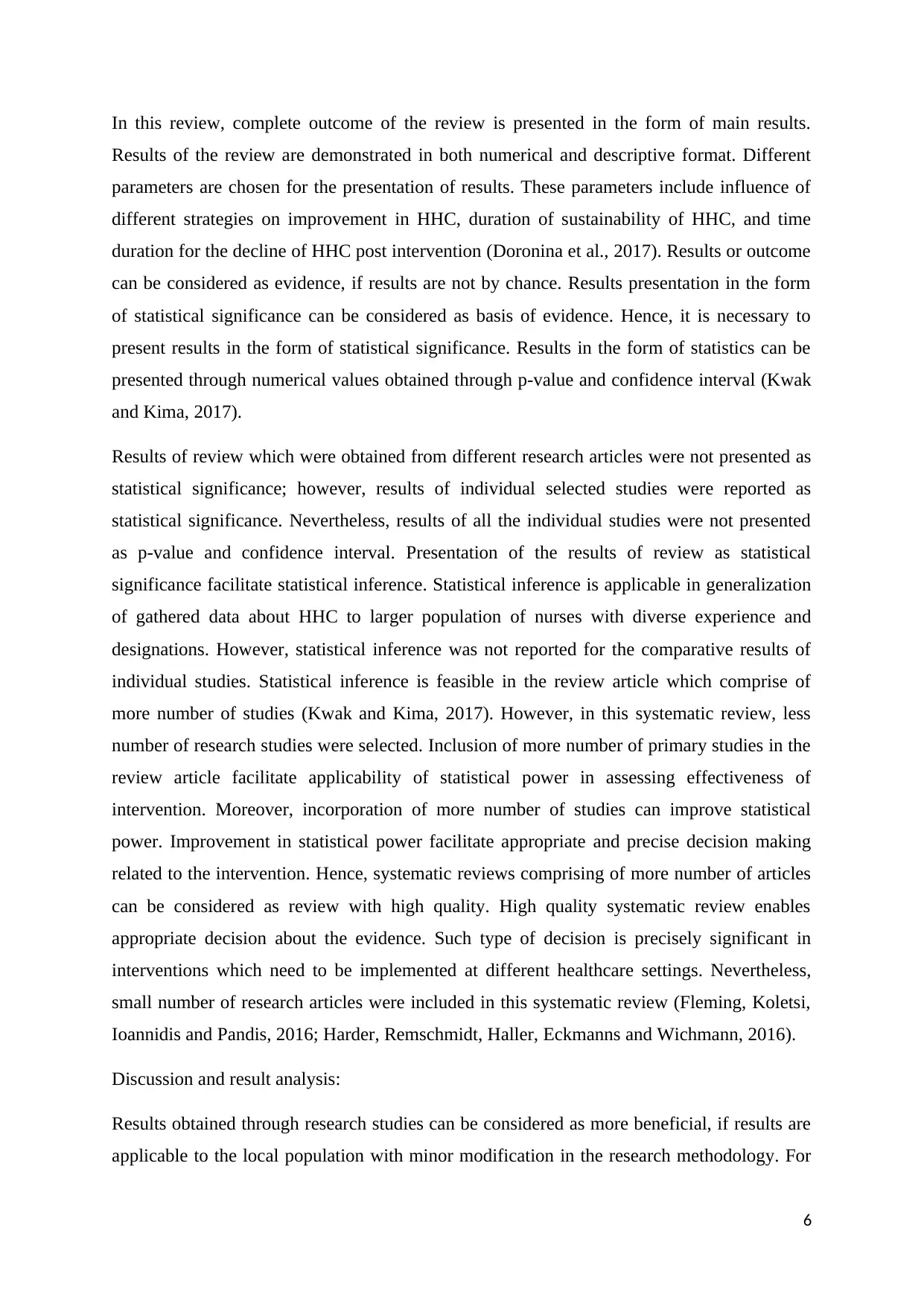
In this review, complete outcome of the review is presented in the form of main results.
Results of the review are demonstrated in both numerical and descriptive format. Different
parameters are chosen for the presentation of results. These parameters include influence of
different strategies on improvement in HHC, duration of sustainability of HHC, and time
duration for the decline of HHC post intervention (Doronina et al., 2017). Results or outcome
can be considered as evidence, if results are not by chance. Results presentation in the form
of statistical significance can be considered as basis of evidence. Hence, it is necessary to
present results in the form of statistical significance. Results in the form of statistics can be
presented through numerical values obtained through p-value and confidence interval (Kwak
and Kima, 2017).
Results of review which were obtained from different research articles were not presented as
statistical significance; however, results of individual selected studies were reported as
statistical significance. Nevertheless, results of all the individual studies were not presented
as p-value and confidence interval. Presentation of the results of review as statistical
significance facilitate statistical inference. Statistical inference is applicable in generalization
of gathered data about HHC to larger population of nurses with diverse experience and
designations. However, statistical inference was not reported for the comparative results of
individual studies. Statistical inference is feasible in the review article which comprise of
more number of studies (Kwak and Kima, 2017). However, in this systematic review, less
number of research studies were selected. Inclusion of more number of primary studies in the
review article facilitate applicability of statistical power in assessing effectiveness of
intervention. Moreover, incorporation of more number of studies can improve statistical
power. Improvement in statistical power facilitate appropriate and precise decision making
related to the intervention. Hence, systematic reviews comprising of more number of articles
can be considered as review with high quality. High quality systematic review enables
appropriate decision about the evidence. Such type of decision is precisely significant in
interventions which need to be implemented at different healthcare settings. Nevertheless,
small number of research articles were included in this systematic review (Fleming, Koletsi,
Ioannidis and Pandis, 2016; Harder, Remschmidt, Haller, Eckmanns and Wichmann, 2016).
Discussion and result analysis:
Results obtained through research studies can be considered as more beneficial, if results are
applicable to the local population with minor modification in the research methodology. For
6
Results of the review are demonstrated in both numerical and descriptive format. Different
parameters are chosen for the presentation of results. These parameters include influence of
different strategies on improvement in HHC, duration of sustainability of HHC, and time
duration for the decline of HHC post intervention (Doronina et al., 2017). Results or outcome
can be considered as evidence, if results are not by chance. Results presentation in the form
of statistical significance can be considered as basis of evidence. Hence, it is necessary to
present results in the form of statistical significance. Results in the form of statistics can be
presented through numerical values obtained through p-value and confidence interval (Kwak
and Kima, 2017).
Results of review which were obtained from different research articles were not presented as
statistical significance; however, results of individual selected studies were reported as
statistical significance. Nevertheless, results of all the individual studies were not presented
as p-value and confidence interval. Presentation of the results of review as statistical
significance facilitate statistical inference. Statistical inference is applicable in generalization
of gathered data about HHC to larger population of nurses with diverse experience and
designations. However, statistical inference was not reported for the comparative results of
individual studies. Statistical inference is feasible in the review article which comprise of
more number of studies (Kwak and Kima, 2017). However, in this systematic review, less
number of research studies were selected. Inclusion of more number of primary studies in the
review article facilitate applicability of statistical power in assessing effectiveness of
intervention. Moreover, incorporation of more number of studies can improve statistical
power. Improvement in statistical power facilitate appropriate and precise decision making
related to the intervention. Hence, systematic reviews comprising of more number of articles
can be considered as review with high quality. High quality systematic review enables
appropriate decision about the evidence. Such type of decision is precisely significant in
interventions which need to be implemented at different healthcare settings. Nevertheless,
small number of research articles were included in this systematic review (Fleming, Koletsi,
Ioannidis and Pandis, 2016; Harder, Remschmidt, Haller, Eckmanns and Wichmann, 2016).
Discussion and result analysis:
Results obtained through research studies can be considered as more beneficial, if results are
applicable to the local population with minor modification in the research methodology. For
6
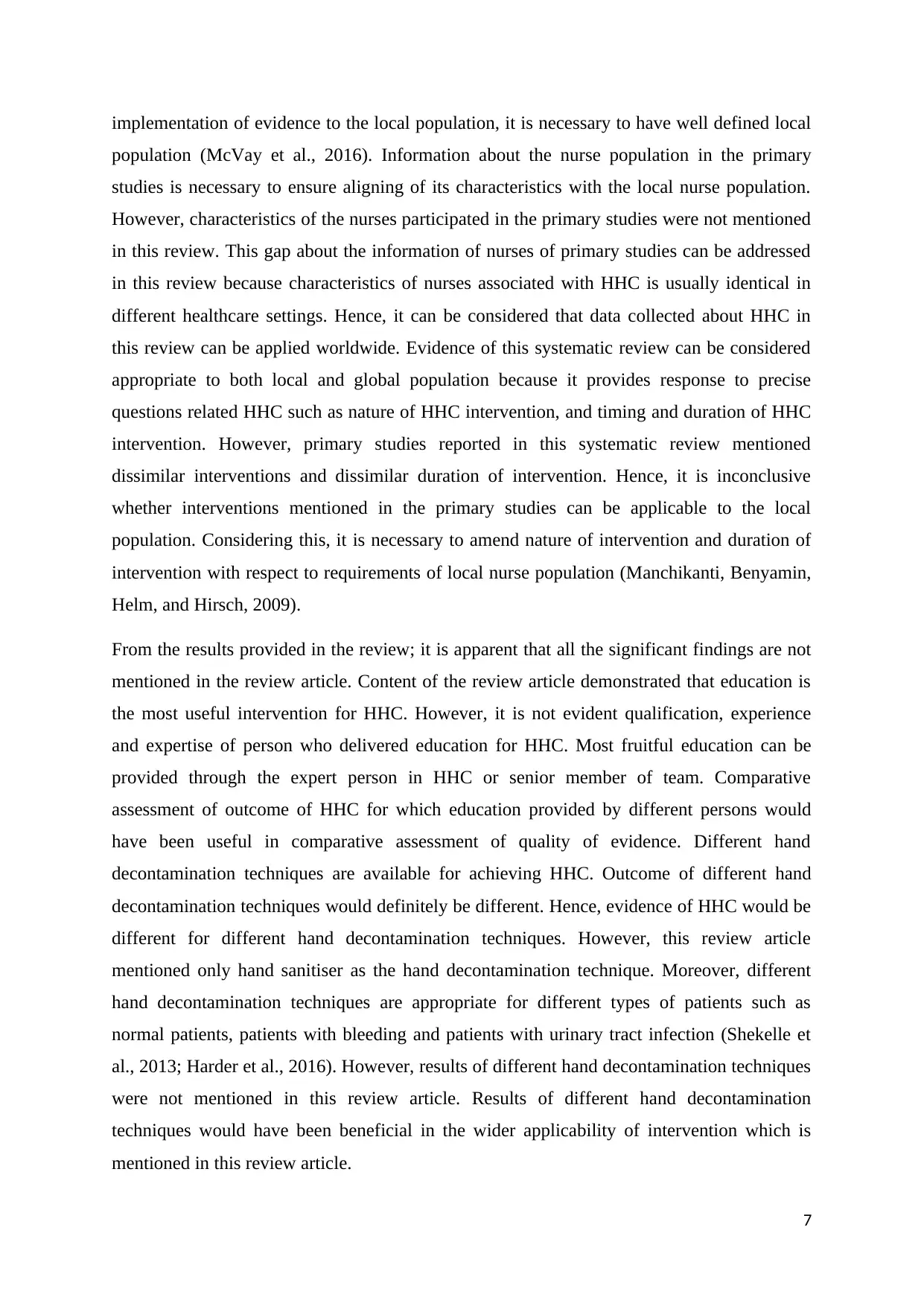
implementation of evidence to the local population, it is necessary to have well defined local
population (McVay et al., 2016). Information about the nurse population in the primary
studies is necessary to ensure aligning of its characteristics with the local nurse population.
However, characteristics of the nurses participated in the primary studies were not mentioned
in this review. This gap about the information of nurses of primary studies can be addressed
in this review because characteristics of nurses associated with HHC is usually identical in
different healthcare settings. Hence, it can be considered that data collected about HHC in
this review can be applied worldwide. Evidence of this systematic review can be considered
appropriate to both local and global population because it provides response to precise
questions related HHC such as nature of HHC intervention, and timing and duration of HHC
intervention. However, primary studies reported in this systematic review mentioned
dissimilar interventions and dissimilar duration of intervention. Hence, it is inconclusive
whether interventions mentioned in the primary studies can be applicable to the local
population. Considering this, it is necessary to amend nature of intervention and duration of
intervention with respect to requirements of local nurse population (Manchikanti, Benyamin,
Helm, and Hirsch, 2009).
From the results provided in the review; it is apparent that all the significant findings are not
mentioned in the review article. Content of the review article demonstrated that education is
the most useful intervention for HHC. However, it is not evident qualification, experience
and expertise of person who delivered education for HHC. Most fruitful education can be
provided through the expert person in HHC or senior member of team. Comparative
assessment of outcome of HHC for which education provided by different persons would
have been useful in comparative assessment of quality of evidence. Different hand
decontamination techniques are available for achieving HHC. Outcome of different hand
decontamination techniques would definitely be different. Hence, evidence of HHC would be
different for different hand decontamination techniques. However, this review article
mentioned only hand sanitiser as the hand decontamination technique. Moreover, different
hand decontamination techniques are appropriate for different types of patients such as
normal patients, patients with bleeding and patients with urinary tract infection (Shekelle et
al., 2013; Harder et al., 2016). However, results of different hand decontamination techniques
were not mentioned in this review article. Results of different hand decontamination
techniques would have been beneficial in the wider applicability of intervention which is
mentioned in this review article.
7
population (McVay et al., 2016). Information about the nurse population in the primary
studies is necessary to ensure aligning of its characteristics with the local nurse population.
However, characteristics of the nurses participated in the primary studies were not mentioned
in this review. This gap about the information of nurses of primary studies can be addressed
in this review because characteristics of nurses associated with HHC is usually identical in
different healthcare settings. Hence, it can be considered that data collected about HHC in
this review can be applied worldwide. Evidence of this systematic review can be considered
appropriate to both local and global population because it provides response to precise
questions related HHC such as nature of HHC intervention, and timing and duration of HHC
intervention. However, primary studies reported in this systematic review mentioned
dissimilar interventions and dissimilar duration of intervention. Hence, it is inconclusive
whether interventions mentioned in the primary studies can be applicable to the local
population. Considering this, it is necessary to amend nature of intervention and duration of
intervention with respect to requirements of local nurse population (Manchikanti, Benyamin,
Helm, and Hirsch, 2009).
From the results provided in the review; it is apparent that all the significant findings are not
mentioned in the review article. Content of the review article demonstrated that education is
the most useful intervention for HHC. However, it is not evident qualification, experience
and expertise of person who delivered education for HHC. Most fruitful education can be
provided through the expert person in HHC or senior member of team. Comparative
assessment of outcome of HHC for which education provided by different persons would
have been useful in comparative assessment of quality of evidence. Different hand
decontamination techniques are available for achieving HHC. Outcome of different hand
decontamination techniques would definitely be different. Hence, evidence of HHC would be
different for different hand decontamination techniques. However, this review article
mentioned only hand sanitiser as the hand decontamination technique. Moreover, different
hand decontamination techniques are appropriate for different types of patients such as
normal patients, patients with bleeding and patients with urinary tract infection (Shekelle et
al., 2013; Harder et al., 2016). However, results of different hand decontamination techniques
were not mentioned in this review article. Results of different hand decontamination
techniques would have been beneficial in the wider applicability of intervention which is
mentioned in this review article.
7
Paraphrase This Document
Need a fresh take? Get an instant paraphrase of this document with our AI Paraphraser
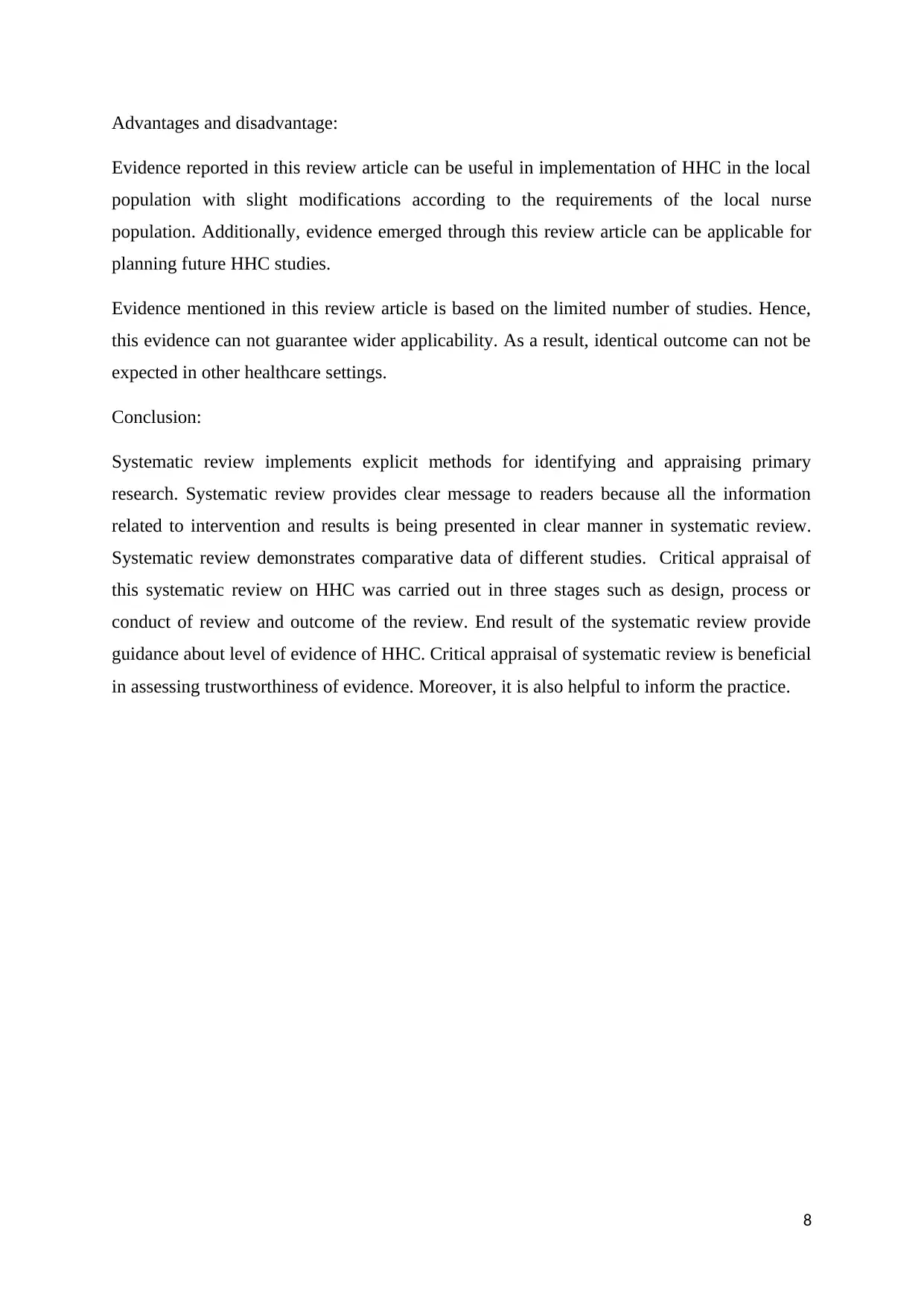
Advantages and disadvantage:
Evidence reported in this review article can be useful in implementation of HHC in the local
population with slight modifications according to the requirements of the local nurse
population. Additionally, evidence emerged through this review article can be applicable for
planning future HHC studies.
Evidence mentioned in this review article is based on the limited number of studies. Hence,
this evidence can not guarantee wider applicability. As a result, identical outcome can not be
expected in other healthcare settings.
Conclusion:
Systematic review implements explicit methods for identifying and appraising primary
research. Systematic review provides clear message to readers because all the information
related to intervention and results is being presented in clear manner in systematic review.
Systematic review demonstrates comparative data of different studies. Critical appraisal of
this systematic review on HHC was carried out in three stages such as design, process or
conduct of review and outcome of the review. End result of the systematic review provide
guidance about level of evidence of HHC. Critical appraisal of systematic review is beneficial
in assessing trustworthiness of evidence. Moreover, it is also helpful to inform the practice.
8
Evidence reported in this review article can be useful in implementation of HHC in the local
population with slight modifications according to the requirements of the local nurse
population. Additionally, evidence emerged through this review article can be applicable for
planning future HHC studies.
Evidence mentioned in this review article is based on the limited number of studies. Hence,
this evidence can not guarantee wider applicability. As a result, identical outcome can not be
expected in other healthcare settings.
Conclusion:
Systematic review implements explicit methods for identifying and appraising primary
research. Systematic review provides clear message to readers because all the information
related to intervention and results is being presented in clear manner in systematic review.
Systematic review demonstrates comparative data of different studies. Critical appraisal of
this systematic review on HHC was carried out in three stages such as design, process or
conduct of review and outcome of the review. End result of the systematic review provide
guidance about level of evidence of HHC. Critical appraisal of systematic review is beneficial
in assessing trustworthiness of evidence. Moreover, it is also helpful to inform the practice.
8
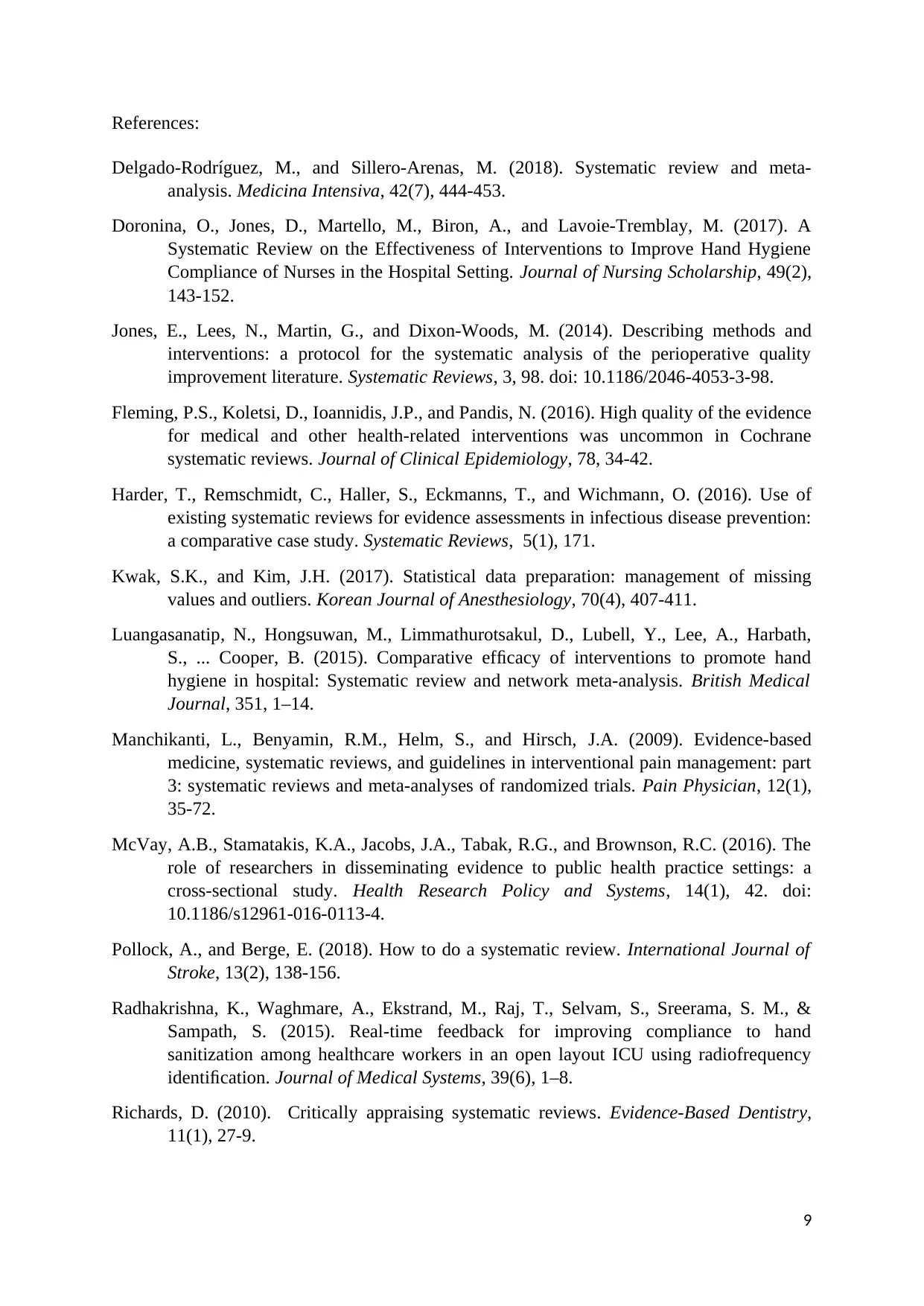
References:
Delgado-Rodríguez, M., and Sillero-Arenas, M. (2018). Systematic review and meta-
analysis. Medicina Intensiva, 42(7), 444-453.
Doronina, O., Jones, D., Martello, M., Biron, A., and Lavoie-Tremblay, M. (2017). A
Systematic Review on the Effectiveness of Interventions to Improve Hand Hygiene
Compliance of Nurses in the Hospital Setting. Journal of Nursing Scholarship, 49(2),
143-152.
Jones, E., Lees, N., Martin, G., and Dixon-Woods, M. (2014). Describing methods and
interventions: a protocol for the systematic analysis of the perioperative quality
improvement literature. Systematic Reviews, 3, 98. doi: 10.1186/2046-4053-3-98.
Fleming, P.S., Koletsi, D., Ioannidis, J.P., and Pandis, N. (2016). High quality of the evidence
for medical and other health-related interventions was uncommon in Cochrane
systematic reviews. Journal of Clinical Epidemiology, 78, 34-42.
Harder, T., Remschmidt, C., Haller, S., Eckmanns, T., and Wichmann, O. (2016). Use of
existing systematic reviews for evidence assessments in infectious disease prevention:
a comparative case study. Systematic Reviews, 5(1), 171.
Kwak, S.K., and Kim, J.H. (2017). Statistical data preparation: management of missing
values and outliers. Korean Journal of Anesthesiology, 70(4), 407-411.
Luangasanatip, N., Hongsuwan, M., Limmathurotsakul, D., Lubell, Y., Lee, A., Harbath,
S., ... Cooper, B. (2015). Comparative efficacy of interventions to promote hand
hygiene in hospital: Systematic review and network meta-analysis. British Medical
Journal, 351, 1–14.
Manchikanti, L., Benyamin, R.M., Helm, S., and Hirsch, J.A. (2009). Evidence-based
medicine, systematic reviews, and guidelines in interventional pain management: part
3: systematic reviews and meta-analyses of randomized trials. Pain Physician, 12(1),
35-72.
McVay, A.B., Stamatakis, K.A., Jacobs, J.A., Tabak, R.G., and Brownson, R.C. (2016). The
role of researchers in disseminating evidence to public health practice settings: a
cross-sectional study. Health Research Policy and Systems, 14(1), 42. doi:
10.1186/s12961-016-0113-4.
Pollock, A., and Berge, E. (2018). How to do a systematic review. International Journal of
Stroke, 13(2), 138-156.
Radhakrishna, K., Waghmare, A., Ekstrand, M., Raj, T., Selvam, S., Sreerama, S. M., &
Sampath, S. (2015). Real-time feedback for improving compliance to hand
sanitization among healthcare workers in an open layout ICU using radiofrequency
identification. Journal of Medical Systems, 39(6), 1–8.
Richards, D. (2010). Critically appraising systematic reviews. Evidence-Based Dentistry,
11(1), 27-9.
9
Delgado-Rodríguez, M., and Sillero-Arenas, M. (2018). Systematic review and meta-
analysis. Medicina Intensiva, 42(7), 444-453.
Doronina, O., Jones, D., Martello, M., Biron, A., and Lavoie-Tremblay, M. (2017). A
Systematic Review on the Effectiveness of Interventions to Improve Hand Hygiene
Compliance of Nurses in the Hospital Setting. Journal of Nursing Scholarship, 49(2),
143-152.
Jones, E., Lees, N., Martin, G., and Dixon-Woods, M. (2014). Describing methods and
interventions: a protocol for the systematic analysis of the perioperative quality
improvement literature. Systematic Reviews, 3, 98. doi: 10.1186/2046-4053-3-98.
Fleming, P.S., Koletsi, D., Ioannidis, J.P., and Pandis, N. (2016). High quality of the evidence
for medical and other health-related interventions was uncommon in Cochrane
systematic reviews. Journal of Clinical Epidemiology, 78, 34-42.
Harder, T., Remschmidt, C., Haller, S., Eckmanns, T., and Wichmann, O. (2016). Use of
existing systematic reviews for evidence assessments in infectious disease prevention:
a comparative case study. Systematic Reviews, 5(1), 171.
Kwak, S.K., and Kim, J.H. (2017). Statistical data preparation: management of missing
values and outliers. Korean Journal of Anesthesiology, 70(4), 407-411.
Luangasanatip, N., Hongsuwan, M., Limmathurotsakul, D., Lubell, Y., Lee, A., Harbath,
S., ... Cooper, B. (2015). Comparative efficacy of interventions to promote hand
hygiene in hospital: Systematic review and network meta-analysis. British Medical
Journal, 351, 1–14.
Manchikanti, L., Benyamin, R.M., Helm, S., and Hirsch, J.A. (2009). Evidence-based
medicine, systematic reviews, and guidelines in interventional pain management: part
3: systematic reviews and meta-analyses of randomized trials. Pain Physician, 12(1),
35-72.
McVay, A.B., Stamatakis, K.A., Jacobs, J.A., Tabak, R.G., and Brownson, R.C. (2016). The
role of researchers in disseminating evidence to public health practice settings: a
cross-sectional study. Health Research Policy and Systems, 14(1), 42. doi:
10.1186/s12961-016-0113-4.
Pollock, A., and Berge, E. (2018). How to do a systematic review. International Journal of
Stroke, 13(2), 138-156.
Radhakrishna, K., Waghmare, A., Ekstrand, M., Raj, T., Selvam, S., Sreerama, S. M., &
Sampath, S. (2015). Real-time feedback for improving compliance to hand
sanitization among healthcare workers in an open layout ICU using radiofrequency
identification. Journal of Medical Systems, 39(6), 1–8.
Richards, D. (2010). Critically appraising systematic reviews. Evidence-Based Dentistry,
11(1), 27-9.
9
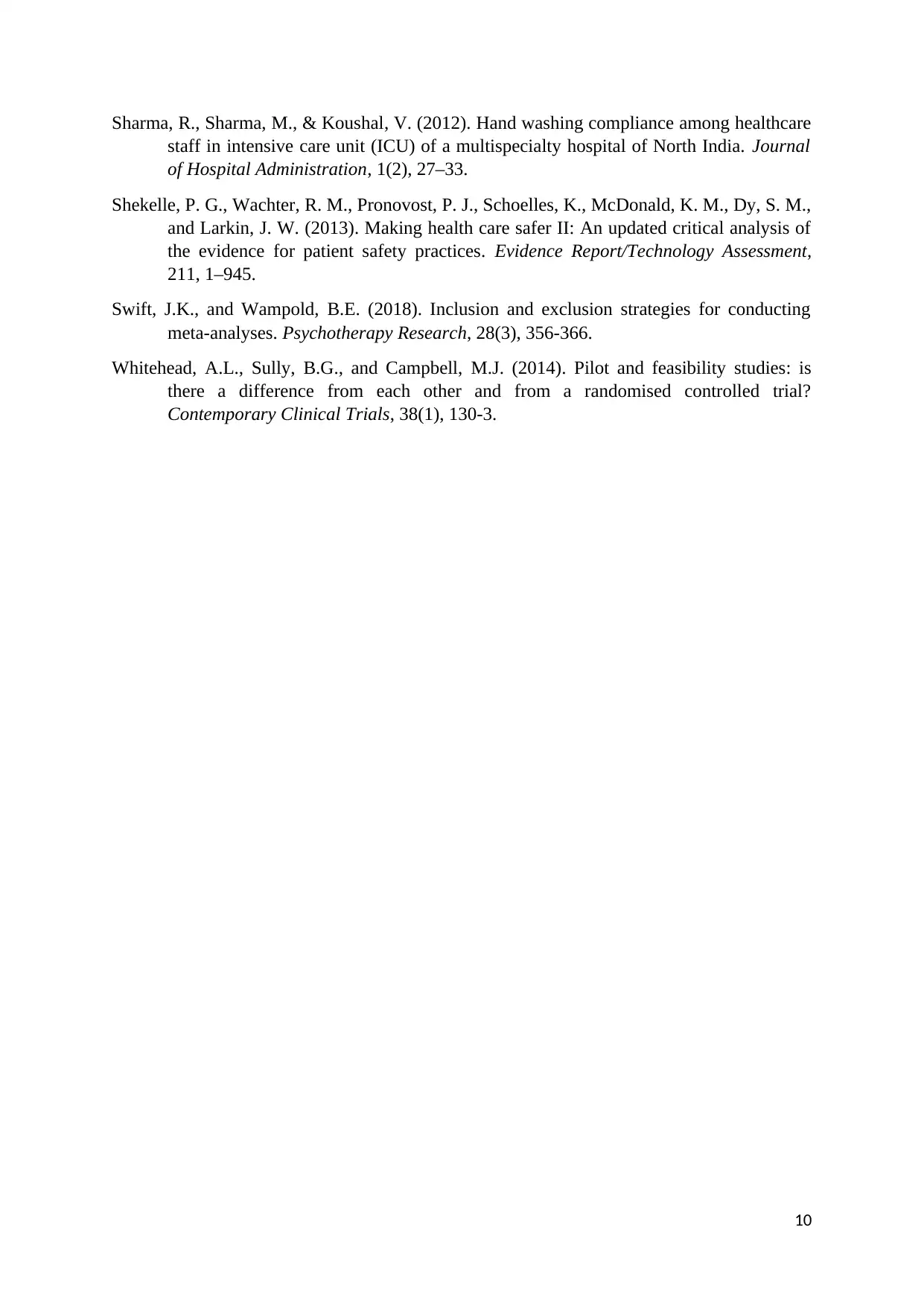
Sharma, R., Sharma, M., & Koushal, V. (2012). Hand washing compliance among healthcare
staff in intensive care unit (ICU) of a multispecialty hospital of North India. Journal
of Hospital Administration, 1(2), 27–33.
Shekelle, P. G., Wachter, R. M., Pronovost, P. J., Schoelles, K., McDonald, K. M., Dy, S. M.,
and Larkin, J. W. (2013). Making health care safer II: An updated critical analysis of
the evidence for patient safety practices. Evidence Report/Technology Assessment,
211, 1–945.
Swift, J.K., and Wampold, B.E. (2018). Inclusion and exclusion strategies for conducting
meta-analyses. Psychotherapy Research, 28(3), 356-366.
Whitehead, A.L., Sully, B.G., and Campbell, M.J. (2014). Pilot and feasibility studies: is
there a difference from each other and from a randomised controlled trial?
Contemporary Clinical Trials, 38(1), 130-3.
10
staff in intensive care unit (ICU) of a multispecialty hospital of North India. Journal
of Hospital Administration, 1(2), 27–33.
Shekelle, P. G., Wachter, R. M., Pronovost, P. J., Schoelles, K., McDonald, K. M., Dy, S. M.,
and Larkin, J. W. (2013). Making health care safer II: An updated critical analysis of
the evidence for patient safety practices. Evidence Report/Technology Assessment,
211, 1–945.
Swift, J.K., and Wampold, B.E. (2018). Inclusion and exclusion strategies for conducting
meta-analyses. Psychotherapy Research, 28(3), 356-366.
Whitehead, A.L., Sully, B.G., and Campbell, M.J. (2014). Pilot and feasibility studies: is
there a difference from each other and from a randomised controlled trial?
Contemporary Clinical Trials, 38(1), 130-3.
10
1 out of 10
Related Documents
Your All-in-One AI-Powered Toolkit for Academic Success.
+13062052269
info@desklib.com
Available 24*7 on WhatsApp / Email
![[object Object]](/_next/static/media/star-bottom.7253800d.svg)
Unlock your academic potential
© 2024 | Zucol Services PVT LTD | All rights reserved.





